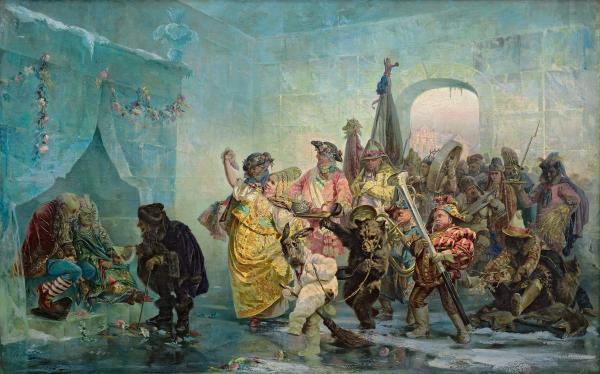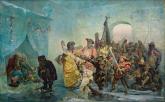The Ice House
1878
- Period Late 19th century
- Share
Fancy dress balls were very popular among the Russian nobility of the eighteenth century. Although by that time their external appearance was already entirely European, they were not always marked by the same European refinement. The wedding of the court jester of Prince Golitsyn and the jester of Buzheninova, held by Empress Anna Ioannovna on 6 February 1740 in an ice house on the Neva, was one of the most original, but also absurd and crude, ventures of her ten - year reign.
The banquet is over and the newly - weds have set off, accompanied by their numerous and brightly coloured procession, in their previous order, to the ice house. Here, to the sound of trumpets, kettle drums and oboes and choir of goats, bulls, dogs and donkeys, they have been let out of their iron cage and led with fitting honour to the bedroom, where they have been locked in. The convoy has dispersed. Sentries have been placed outside the house so that the loving couple make their cannot escape. Such is the altar to Hymen... Everything you sit on or touch is ice - the walls, the wedding bed, the gob lets. Everything blazes with the cold; closer, tighter, finally smothering and freezing them.
[I. Lazhechnikov, The Ice House] Play and Passion in Russian Fine Art. St-Petersburg. 1999. P. 152.
Valery Jacoby painted a whole series of pictures with subjects taken from the time of Empress Anna Ioannovna. The painting The Ice House occupies a special place among them, and depicts one of the strangest episodes in the life of the imperial court.
The Ice House was built on the square between the Admiralty and the Winter Palace during Shrovetide in 1739. The outside walls and the inner décor were entirely made of ice. The Ice House was the site of the marriage of the Empress’s jester Prince Mikhail Golitsyn to her female jester Eudoxia Buzheninova (probably a deliberate nickname, as buzhenina was the Empress’s favourite dish, cold baked pork). Besides the Empress and her courtiers, the wedding festivities were attended by a total of 150 representatives of the various nationalities inhabiting the Russian Empire, including Ukrainians, White Russians, Finns, Tatars, Komi-Zyrians and Kamchadals (Itelmens). The guests donned their national attire and engaged in traditional folk dancing. When the feast was over, the newly-weds were taken back to the Ice House and locked in for the night.
The story of the jester’s wedding led Ivan Lazhechnikov to write a critical novel entitled The Ice House. Although Valery Jacoby appears to have read the book, his painting concentrates more on the external facets of the episode. The artist depicts the bright and motley crowd dancing before the Empress and her courtiers.

